 |
|
 |
2023
November
29
|
Christians against light pollution
Light pollution is what we call wasteful outdoor lighting that makes it hard
or impossible to see the stars. Typically it comes from lights that shine upward
into the sky (and into our eyes) without shielding.
To my surprise and delight, Christianity Today Magazine has taken a stand against it.
In the latest issue, both an editorial and an article make the point that
it is spiritually unhealthy to hide something beautiful that we are supposed to be in awe of.
It's an ungrateful and disrespectful attitude toward the beauty of nature.
The majesty of the sky is part of God's revelation (Psalm 19).
They also mention, briefly, the harm done to wildlife by light pollution.
I'm not sure if they get to the third consideration, which is the environmental impact
of making electricity for lights nobody needs.
Many non-Christians will surely agree that hiding the beauty of the sky is an unwise,
self-centered thing to do.
Permanent link to this entry
"Conspiracy" does not mean "conspiracy theory"
I'm seeing headlines that say "conspiracy" as short for "conspiracy theory."
If this keeps up, we're going to have a lot of trouble communicating.
Watergate, for instance, was a conspiracy, not a conspiracy theory,
and by that I mean it was a group of people really getting together to do wrong.
I can see what's happening. The phrase "conspiracy theory" in recent years has been
used much more than any actual discussion of conspiracies, and often in a context where
what is being alleged is not a plausible conspiracy. (Almost by definition,
a "conspiracy theory" is something illogical, not a plausible theory about
a potentially real conspiracy.)
Batten down the hatches, there's confusion ahead! At the very least I now have to be
careful to make clear what I mean when I say either "conspiracy" or "conspiracy theory,"
or people will misunderstand.
Permanent link to this entry


|
2023
November
26
|
Canon 60Da:
How we know ISO 800 is "native" and 640 is scaled
Prompted by a discussion
started by "sharkmelley" on Cloudy Nights Forums,
I just discovered something surprising (but reassuring) about my Canon 60Da,
which I now think is the best camera for astrophotography that Canon has made.
Previously, looking at
PhotonsToPhotos
(click that link for this exact chart in full),
I saw that ISO speeds came in groups of three:
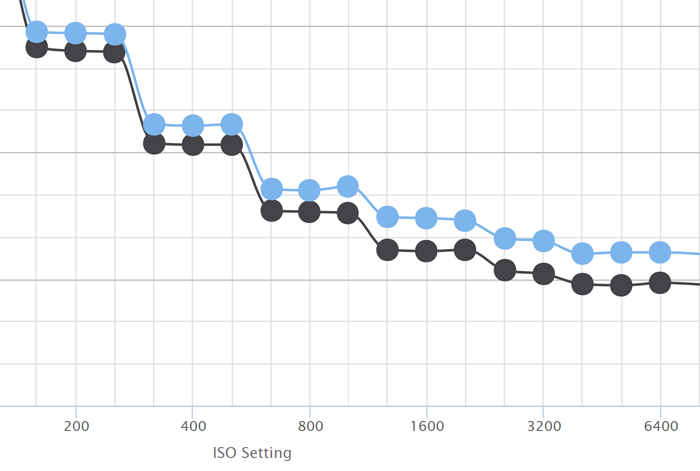
(The two graphs are for two cameras that should have the same sensor, to show the
range of uncertainty, which probably depends mostly on sensor temperature.)
I figured the lowest in each set was delivered by the sensor at a particular gain setting,
and the others were obtained by scaling the numbers up. So I decided to use ISO 640
(and, potentially, ISO 1250) as my standard speeds.
You've seen lots of astrophotography at ISO 640 in the Daily Notebook his year.
Well... I tested the histograms for gaps. Fortunately there are none with this camera. But instead I found
spikes ("stegosaurus fins" I nicknamed them):

This is a histogram of a flat field taken at ISO 640, examined with
RawDigger set for a bin width of 1 (which is crucial).
If I use ISO 800 instead, the "fins" are absent or greatly subdued:

That tells me ISO 800 is giving me the digital data in a straightforward way, and
ISO 640 is scaled down from that.
(By the way, the fins did not go away at ISO 1000, so I decided to stick with 800.)
What happens is, if you take a smoothly distributed set of integer values and multiply
them by a number near but less than 1, giving integers again, then you get some
doubling up — after the scaling, two different integers can give the same result.
Apparently, this camera takes an image at ISO 800, in integers, and then multiplies
the values by 640/800 = 0.8 to give the ISO 640 image.
Worse, if you multiply by a number near but greater than 1, you get gaps in
the histogram — some integers will never be hit at all. This is common in DSLRs
and mirrorless cameras, though I have never caught the 60Da doing it, and it can
show up in astrophotos because we often have smooth gradients that are very underexposed,
so that if the brightness along a gradient goes 20, 19, 18, 16, 15 (skipping 17) you'll
see a step or posterization effect.
For the mathematics of how this happens,
click here, which happens to also be a demonstration of Quarto,
a successor for RMarkdown for the R programming language.
The input file (.qmd file) is here.
Anyhow, I've adopted ISO 800 and 1600 as my preferred speeds and have already taken a
set of dark frames for my library — the first of many sets, because this camera is
not temperature-controlled, and I'll need sets for many different temperatures.


|
2023
November
24
|
A "word problem"
Yesterday my granddaughter was amused by this arithmetic word problem:
A car is going down the street with 7 people in it, on 4 wheels. How many
tires does it have on it?
Some children (not my granddaughter) have to be clued in that you don't just take
all the numbers in the problem and calculate something. (Not 7+4 or 7×4.) Instead, you think
about what you're trying to find out, and realize that the number of people in the car
doesn't affect the number of tires.
If you just grab all the numbers in the problem and start calculating, you were lost the
moment you set foot in it.
Posting this on Facebook, I quickly found out that some adults have to be
clued in that the question is supposed to be understood straightforwardly —
it is not a trick question. You are not being challenged to think of a creative
way to misunderstand it or a weird situation it might apply to. Yes, a car can be rolling
along on wheels without tires, and have twenty tires hidden in the trunk, but that is
not the situation you were asked to envision.
We linguists recognize a principle called Grice's Maxim of Quality, which can be
summed up as, "People don't normally aim to be misunderstood."
The illusion that all challenging questions are tricks may come from the way
unprepared people experience all questions. If you don't know the context,
or if you aren't good at understanding English, all
questions seem like tricks. But the illusion is definitely fostered by "puzzles" in
newspaper quizzes and on web sites, where the pedantic person running the game tells you
that the obvious answer to a question is "wrong" and
the "right" answer requires some kind of deliberate misunderstanding.
I call foul when people play that game with me.
Permanent link to this entry


|
2023
November
21
|
How many exposures does an astrophoto need?
Alert readers may notice that I've recently switched to stacking about 60 2-minute exposures
when I photograph nebulae or galaxies. (That's a total of 2 hours of exposure per object.)
I used to stack 20. In earlier years I stacked as few as five or ten.
The exact number varies because a few of the exposures are disrupted by airplanes, satellites,
or guiding problems.
How did I arrive at that?
Well, the individual exposures are each 2 minutes at ISO 640 and f/7.
In my location, near the city lights of Athens, that gathers enough light that
the noise of the camera sensor is not a problem.
(See this.) Under a dark country sky, I'd want longer exposures,
a faster f-ratio, and/or a higher ISO setting.
So how many exposures should I stack?
Here are the main principles:
- More are always better. That is, stacking more exposures always reduces the random noise in the image,
allowing it to be stretched to higher contrast to bring out faint detail.
- One is not enough, unless it's simply impossible to take more than one. I learned very early to stack
at least five or so.
- To get a noticeable improvement, I have to double or triple the number of exposures. That improves the
signal-to-noise ratio by a factor of about 1.4 or 1.6 respectively. So, for instance, the improvement changing from 20
to 60 exposures is noticeable. Anything much less isn't perceptible.
- It isn't practical to take an infinite number of exposures. At some point the question becomes,
"How many objects do I want to photograph reasonably well?" rather than "What is the best I can possibly do?"
- There can be such a thing as enough. If the faint detail that I want to photograph is clearly visible and
noise isn't a problem, then I don't actually need to go longer.
The third point, in boldface, is crucial. To get another improvement as big as I got by going from 20 to 60,
I'd have to go to 180, which is 6 hours. And that would mean doing
appreciably less astrophotography, since each photo would take so long.
I have not joined the ranks of those who leave an automated astrophotography setup running all night
while they sleep. I don't quite trust my equipment enough yet (nor our weather!), but it can certainly be done.
Somehow, though, I'm not inclined to do it. Right now, two hours per object is a good
compromise between picture quality and feasibility. If I were photographing a particularly faint,
elusive object, I might do several two-hour sessions over several nights.
Permanent link to this entry


|
2023
November
18
|
The Crab Nebula (M1)
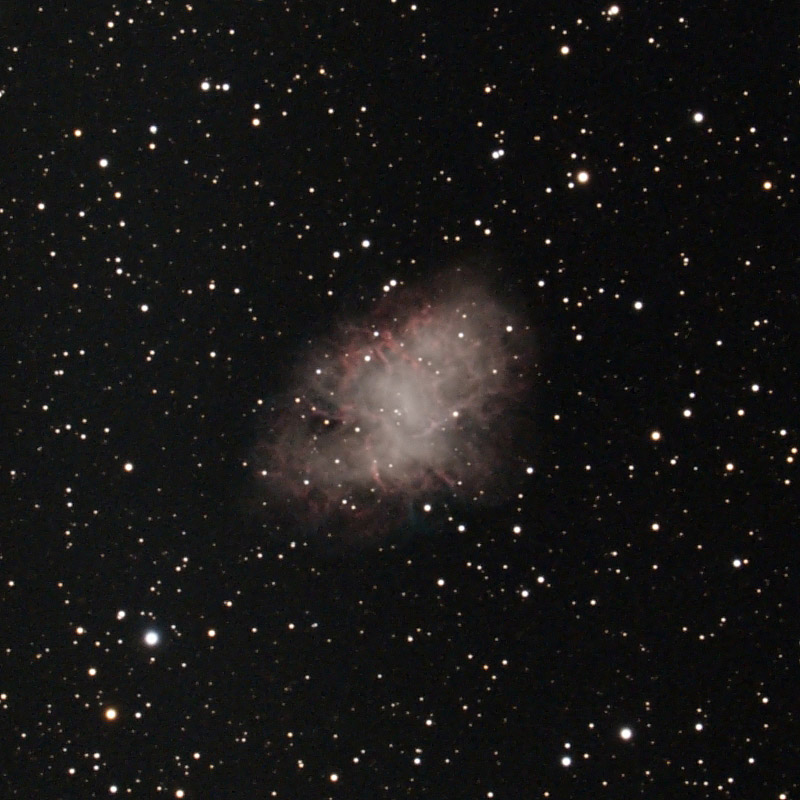
Last night I had a very good astrophotography session. I took two images, each
comprising dozens of exposures.
Here you see the Crab Nebula (Messier 1), the remnant of a supernova that was seen
from Earth in 1054 A.D., although the light had taken about 6,500 years to reach us.
It was discovered in the 1700s, when it was only three quarters its apparent size in
each dimension, and therefore (if I calculate correctly) more than twice as dense and
probably twice as bright in surface brightness. Look at the swirls of color form
ionized gas.
This object is very important to modern astrophysicists
because we are getting a good look at a young
supernova remnant, and it contains, among other things, a pulsar,
a neutron star whose light fluctuates at a frequency of 30 Hz as it rotates.
This pulsar was discovered by Jocelyn Bell at Cambridge.
You can see it in the picture — look at the two stars very close together in
the center of the nebula; it is the one to the lower right.
This is a stack of 66 two-minute exposures with my trusty Canon 60Da camera at ISO 640
on my 8-inch telescope (Celestron 8 EdgeHD with f/7 reducer) and Losmandy GM811G mount
(which provided excellent tracking), controlled by N.I.N.A. and PHD2 software on a ThinkPad T490s.
Most of the time, I was indoors, watching the imaging process by Remote Desktop Protocol,
although whenever I needed or wanted to, I could step outside, use the computer keyboard
there, and make any changes I wanted to.
I am very pleased with this picture, which compares favorably to observatory photos from
the mid-20th century. Stars are visible down to at least magnitude 18; the brightest star
in the picture is magnitude 10.2. This pictures is shown at a larger scale than most of
the images from this telescope that I've shared; you're looking at just the center of the
camera's field.
Permanent link to this entry
Stephan's Quintet at greater length
Pushing an 8-inch telescope to its limit
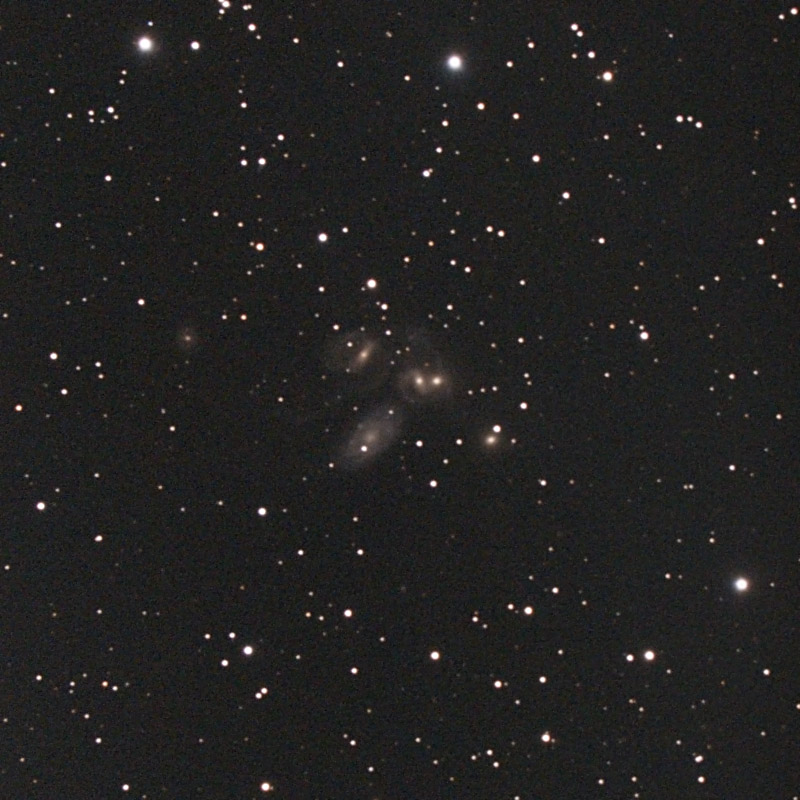
The other day I showed you Stephan's Quintet, a group of five galaxies
(four of which form a group in space), and promised you a better picture of it.
Actually, there are more than five.
Here it is.
This was taken with the same equipment as the Crab Nebula above; it's a stack of 57 rather
than 66 exposures; and it compares favorably to the Palomar Sky Survey images taken with a 48-inch
telescope in the 1950s. Stars are visible down to at least magnitude 18 if not 20.
The galaxies are, from left to right:
NGC 7320C, off by itself on the left, magnitude 17;
NGC 7319 at the upper left corner of the main triangular group, mag. 15;
NGC 7320 below it, the brightest one, magnitude 13;
NGC 7318B, magnitude 14;
NGC 7318A, its companion just to the right of it, also magnitude 14;
NGC 7317, magnitude 14.5.
Except for NGC 7320, which is much closer, these are believed to be about 300 million light-years away.
Permanent link to this entry


|
2023
November
18
(Extra)
|
Computer and AI ethics
Today's quadruple-header is a selection from my LinkedIn postings about computer ethics.
The really alert reader will also notice that some layout problems have been tidied up,
mainly in the interest of accommodating larger pictures more easily.
Computer ethics is NOT some new countercultural thing like vegetarianism,
pacifism, extreme environmental activism, or something.
Ethics is part of the rational pursuit of goals. It is part of good management.
One reason AI ethics is hard:
Some people aren't accustomed to reasoning about ethics at all. For them, right and wrong are just immediate emotional responses to concrete situations. If you throw in some new technology, suddenly the situation isn't familiar and the emotional response doesn't happen.
Let me suggest a different approach. Start with what you definitely believe to be right and wrong. Then think about how this applies to new situations. For example, if it's wrong to steal a dog, it's also wrong to steal an elephant, even though you've probably never encountered a case of elephant theft.
Along the way, distinguish ethics (right/wrong) from laws, regulations, customs, fashions, etc. Stealing money, forgetting to sign a tax form, misspelling a word, and wearing summer clothes after Labor Day are not all the same kind of "wrong."
That's how to get started. A lifetime of careful thinking awaits...
The first sign that somebody is going to do something unethical with AI is often that they talk about what the AI is doing, rather than about what the users or builders of AI are using it for.
"AI has learned to..."
There are always human beings on both ends of the activity.
Permanent link to this entry
That simple...
Sometimes AI ethics can be simple.
We're hearing about a high school student who "used AI" to make "deepfake" nude pictures of his female classmates. (Bad move!)
Well... What if he had simply been a good artist and had made very realistic drawings of his classmates' faces on realistic nude bodies?
That would be the same thing. Adding AI or computers to it doesn't change the rules.
If it's wrong to do something without a computer, it's equally wrong to do it with a computer.
(I never heard any more about the incident or how it was handled.
My concern here was to point out the ethical principle, not
delve into the particular case.)
Permanent link to this entry
More about why people don't want to think about ethics
There are several reasons people may not want to think about the ethics
of what they're doing with computers or AI. Briefly:
(1) They may be under the impression that ethics is mainly about emotions or feelings, which it isn't. It's about whether people benefit or are harmed by actions and whether this is fair. It's closely related to rational pursuit of goals.
(2) They may think they have to defend deep theories of ethics. No; you're not going to have to argue about the existence of God or whether Kant was right about the starry heaven above and the moral law within. In the business world, ethics is almost always a matter of showing people what's consistent with principles they already accept.
(3) They may mix up ethics with things that merely facilitate ethical behavior ("instrumental virtues" as Reid Blackman puts it). Excesses of "political correctness" often come from this confusion. For example: We do not have an ethical duty to have a diverse workplace. Our ethical duty is to be fair. Having a diverse workplace can make it easier to be fair, and often arises naturally
out of fair behavior, but is not the end in itself. Forcing diversity through quotas is, I contend, not fair to individuals.
(4) If trained in management or quantitative science, people may swing too close to utilitarianism ("the greatest benefit for the greatest number") rather than fairness to everyone. Utilitarianism says it's OK to deliberately harm some people to benefit a larger number of others. No...
(5) If very technically inclined, they may be so accustomed to manipulating machines that they see people as objects to manipulate. I have met teenage "hacker wannabees" who had this strange kind of moral blindness and who thought it went with being a computer genius. To them my main message was, "Grow up!"
And, in one sad case, "Be careful what you ask for.
If you really convince us that you cannot tell right from wrong the way other people can, society may decide you need to be in an institution."
On a more pedestrian level, I have had to explain to a grown man that if you trick the machine at a car wash
into letting you use your prepaid card to get more than you paid for, you're stealing.
"The computer let me" is no excuse.
Permanent link to this entry
The New-World Illusion
In computer ethics, "The New-World Illusion" is my name for the illusion that when computers or AI come on the scene, everything is totally new, and your pre-existing common sense doesn't apply.
The worst case of it was something I saw in the 1990s, in the heyday of teenage "hacker wannabees." It transpired that someone had e-mailed a copy of the /etc/passwd file from a UGA laboratory computer to some unknown stranger. (The passwords in it were encrypted, but not strongly enough, a hazard that had just been discovered and not yet mitigated.)
I'm not sure how this was discovered, but as the sysadmins were trying to figure out what to do, the perpetrator walked in and bragged about it! "I'm the elite hacker that send your /etc/passwd file to the other hackers..." He expected to be admired for his cleverness.
Then we saw a remarkable instance of administrative confusion, as people in authority tried to figure out whether he had broken the law, what to do next, and whether any existing rules or laws even applied to it.
Well... Suppose he had gone to UGA's carpentry shop and secretly copied some technical information about the locks they install on doors, and then sent it to would-be burglars. That would be crystal-clear. He would be trying to aid in a crime.
This was the same. I had to explain that remotely accessing and tampering with a machine belonging to UGA has to be illegal, whether the machine is a computer or something else. And helping people try to do that has to be illegal too.
What I was up against was the widespread notion that "computer hacking" was some kind of new supernatural or metaphysical act that was completely beyond the reach of the law because it happened "in cyberspace." That was a surprisingly sticky illusion. People couldn't think their way out of it.
We have the same thing going on now with AI ethics. People think AI has created totally new ethical issues. For the most part, it hasn't. It has made it much easier to do things (such as create fake pictures) that could have been done manually, at greater effort, already, and the right and wrong haven't changed.
Permanent link to this entry


|
2023
November
17
|
Sunset, Edisto Island (2023), by Scott Pope
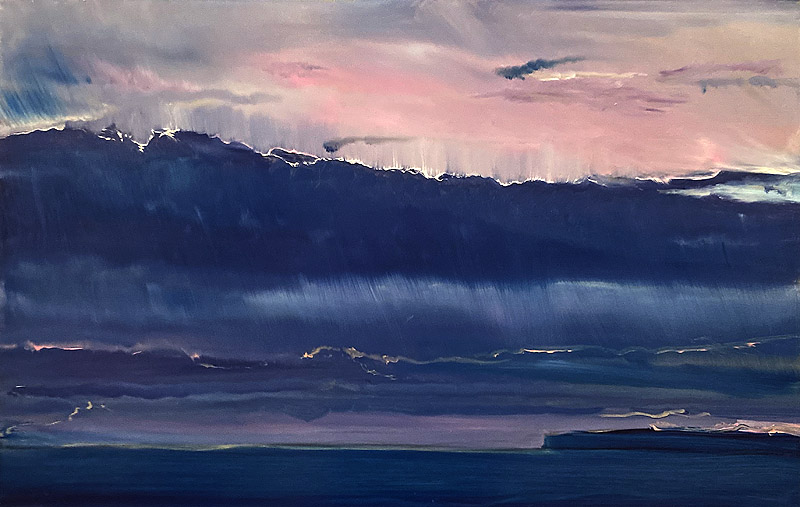
We are now the proud owners of a Scott Pope
painting.
Scott came through the UGA School of Art a few years before Melody did, and was then
the art supply dealer (at The Loft) from whom she bought art supplies during her
student days and subsequently.
Like many of his paintings, this one has colors more vivid than the camera can capture.
Permanent link to this entry


|
2023
November
13
|
Autumnal back yard
A picture composed by Melody and executed and processed by me.
|
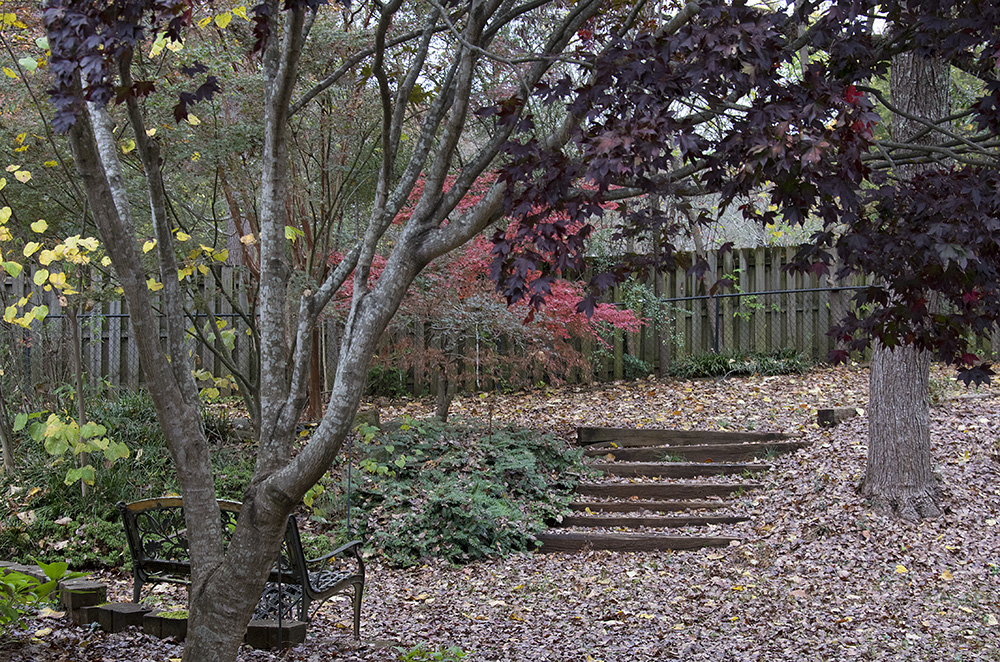
|
| |
Permanent link to this entry


|
2023
November
10
|
NGC 7331 and the Deer Lick Group
On the evening of the 7th, as our series of clear nights continued, I took another
picture of galaxies in Pegasus, this time using the 8-inch telescope.
Scroll down and take a careful look:
|
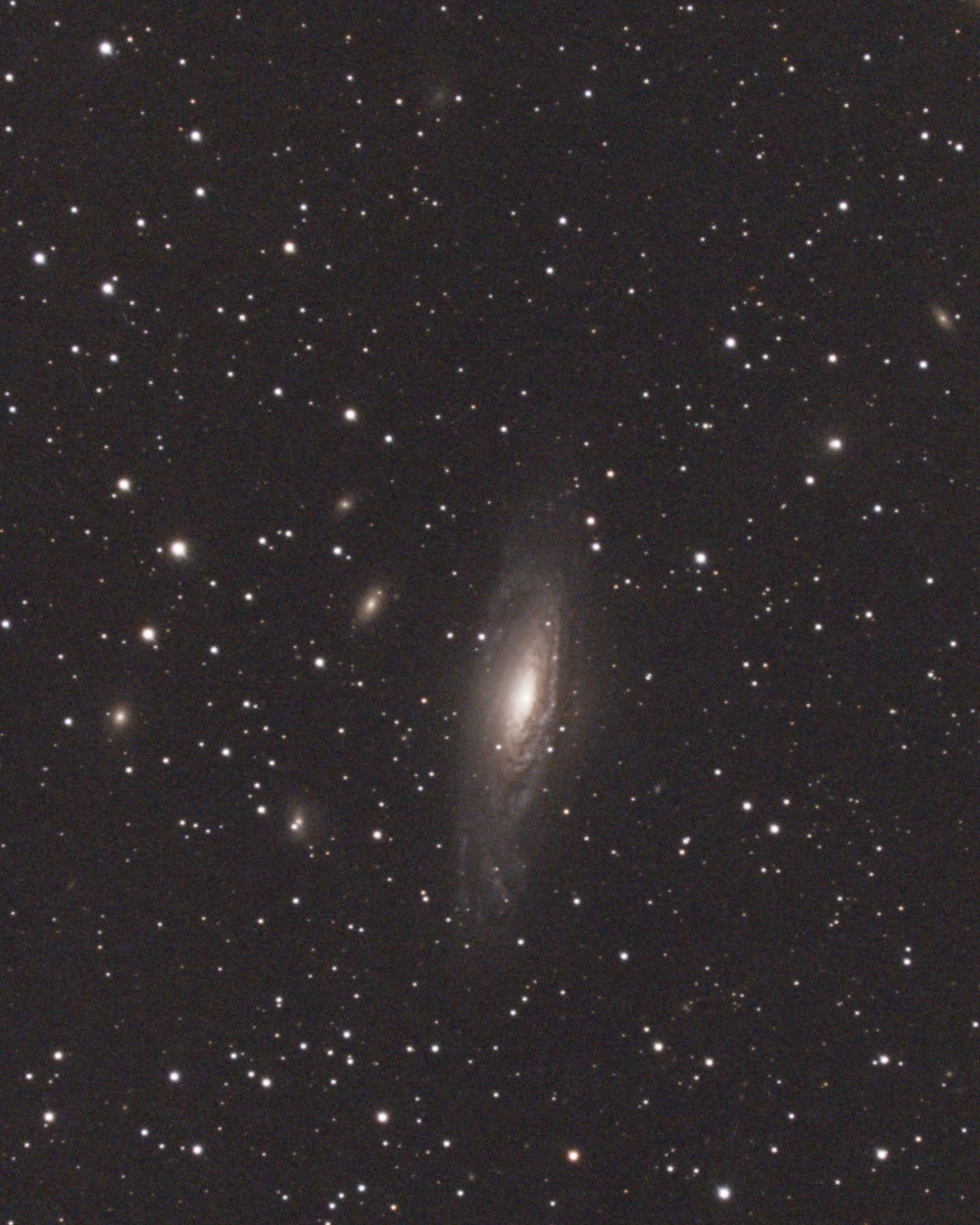
|
| |
The big galaxy is NGC 7331, and the ones immediately to its left are called the Deer Lick Group
and are not actually close to it, nor to each other.
They were named by amateur astronomers who observed them from Deer Lick Gap, North Carolina.
Then the organizers of the Deerlick Astronomy Village (Georgia) named themselves after the galaxy group.
The picture also shows plenty of other scattered, distant galaxies. I haven't tried to count them.
This is a stack of 58 2-minute exposures with a Canon 60Da on a Celestron 8 EdgeHD with f/7
compressor, Losmandy GM811G mount, 60×240 guidescope, ASI120MM camera, and PHD2 and N.I.N.A. software.
Those with a critical eye will note faint streaks coming out of some of the brightest
star images. These are apparently an optical effect, not a guiding problem.
I need to check the telescope for miscollimation and for dirty optics.
[Update:] This appears to be a milder case of the strange effect discussed by
James Lamb on YouTube, an optical distortion
caused by using a Celestron dew heater ring (as I was doing) and aligned with gaps in
the corrector plate support (where there is less metal to carry heat away). I think the
problem is excessive heat in small areas, lending to slight bending of the corrector plate,
but the jury is still out. One take-away point is that the Celestron dew heater ring is
considerably more powerful than other dew heaters when powered the same way. My power was
13.5 volts, about 50% duty cycle, which may have given me more than 20 watts, and I should have used less.
Tests and experiments will continue.
Permanent link to this entry
Stephan's Quintet
Next, I slewed the telescope slightly southward and photographed Stephan's Quintet,
another compact grouping of galaxies of which four, not including the biggest one at the lower left of the group,
form a grouping in space. This is a stack of only 15 exposures because the rotation of the earth
was bringing Pegasus down behind a tree. Consider this a study for a better picture to come.
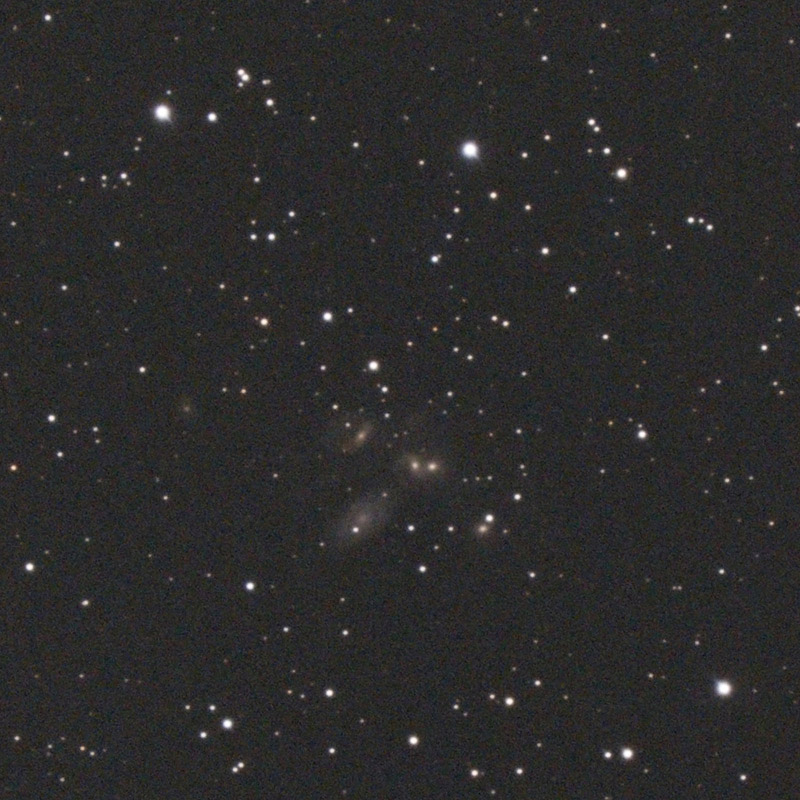
Permanent link to this entry
Remote-control astrophotography with N.I.N.A.
During the whole session, I controlled the telescope and camera with
N.I.N.A., a software package that can completely automate
an observing session.
N.I.N.A. can control telescopes remotely that are thousands of miles away, provided there is a
technician on site to make sure the telescope is set up and physically operational.
My telescope was just outside in the driveway, connected to a laptop, and I did much of the
controlling from right there because I don't have an electronic focuser, nor am I quite sure
cables will never snag as the telescope moves, so I want to be right there to see it.
But much of the time I was indoors, using Remote Desktop Connection to connect to that laptop
from another.
At the start, I told N.I.N.A. to aim at NGC 7331,
so it told the telescope to point there, then took a picture and compared it to its
internal star atlas to check accuracy and made a small correction.
Then it turned on autoguiding and executed my requested series of thirty 2-minute
exposures. Actually, I intervened and re-started the sequence more than once.
Here's what N.I.N.A. looks like in use:
|
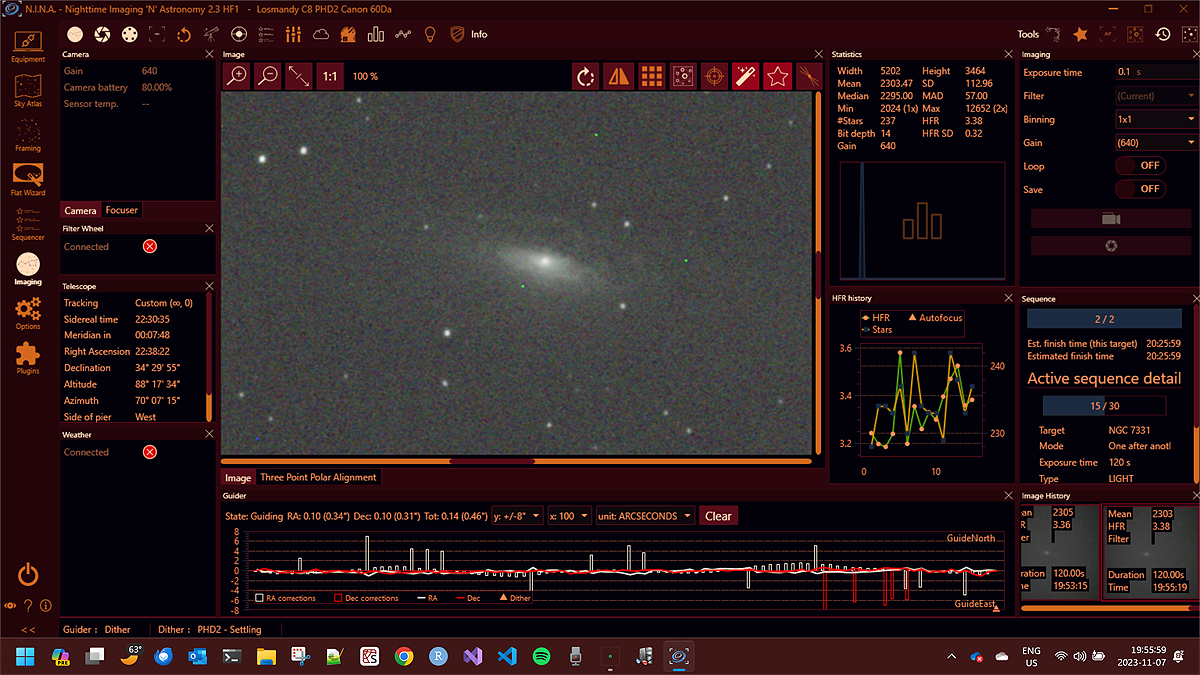
|
| |
There's a lot on the screen. Going down the columns from top to bottom, left to right:
Camera — N.I.N.A. is connected to my Canon 60Da; "gain" is the ISO setting.
Filter wheel and Focuser — I have none.
Telescope — This window tells me where the telescope is pointed.
Notably, the telescope is on the west side of the pier, and the object will cross the meridian
(which might necessitate flipping the mount) in 7 minutes.
Weather — I haven't arranged a source of weather data.
I should either arrange to get weather data over the Internet or close this window so
I can see more of the others.
Now, starting from the top again:
Image — The most recently completed picture, downloaded and stored on
the computer. I'm viewing the central part of this one magnified to judge tracking.
You can see three bluish hot pixels from defects in the sensor or cosmic-ray hits;
they will be removed by processing.
Three Point Polar Alignment — I'm not using it, but N.I.N.A. can perform a
very precise polar-alignment routine that does not require a view of Polaris.
Guider — The graph shows how well the guidescope is tracking a star and what
corrections are being sent to the telescope's motors. This happens to be exceptionally
good tracking, with a total RMS error of 0.46 arc-seconds.
And back to the top for the next column:
Statistics — Information about the brightness and sharpness of the latest image.
The median brightness, which is the sky background, is 2295, and this camera's scale happens to be
from 2048 to 16383. That is as it should be. It's about 250 units above the baseline,
high enough to overcome sensor noise. HFR, or half-flux radius, is a measure of star sharpness,
here 3.38 pixels, a rather large number because this is taken with a long focal length.
HFR History — Graphs of the sharpness and number of stars in successive exposures.
This is a crude but very helpful indication of whether something has gone wrong, such as a
shift in focus or even an incoming cloud.
Last column:
Imaging — This window, which perhaps needs a better name, allows me to view
continuous video ("live view") through the camera in order to focus. It is not in use at
the moment.
Sequence — I'm doing my second of 2 sequences tonight (the first was the flat field
calibration) and have completed 15 of the requested 30 exposures. There's another elaborate user
interface for setting up sequences.
Image History — These are the previous exposures in the series. I can call them up for viewing
and analysis to compare to what I've just taken.
One of the challenges of N.I.N.A. is that we use it on a small screen (which may be a window on another computer)
but it has a lot to show us. All of these sub-windows are scrollable to show more.
They all, in turn, are just one of many screen views that N.I.N.A. offers; there are others
for equipment setup, sequencing, and framing. And yet it works and is surprisingly quick to get used to!
Permanent link to this entry
48 years of friendship and love
November 8th was the 48th anniversary of the day Melody and I met and became best friends.
I've told the story already.
This time, though, I want to add a note of thanks...
...to my mother, for letting me go to the Honors Program event. At the time, my paternal
grandmother was in the hospital in Augusta; we had been to see her the previous weekend;
and we wanted to go as often as we could (only possible when we
had the whole day free). Fortunately, my mother understood that some important people at UGA
(such as the Director of Admissions and Director of the Honors Program) were counting on me
to be at this event, so I wasn't whisked away to Augusta. I don't remember whether my
mother and sister went to Augusta without me. I only remember that I went to UGA, met Melody, and
am very thankful for it.
Permanent link to this entry


|
2023
November
6
|
A galaxy-rich field in Pegasus
Scroll down through this picture and look for things that are not stars.
Many galaxies appear in this picture, most of them very small. Many of them are full-size galaxies as big as ours;
the only reason they look tiny is their distance. I've rendered the picture a bit light
and grayish to make the galaxies easier to see.
|
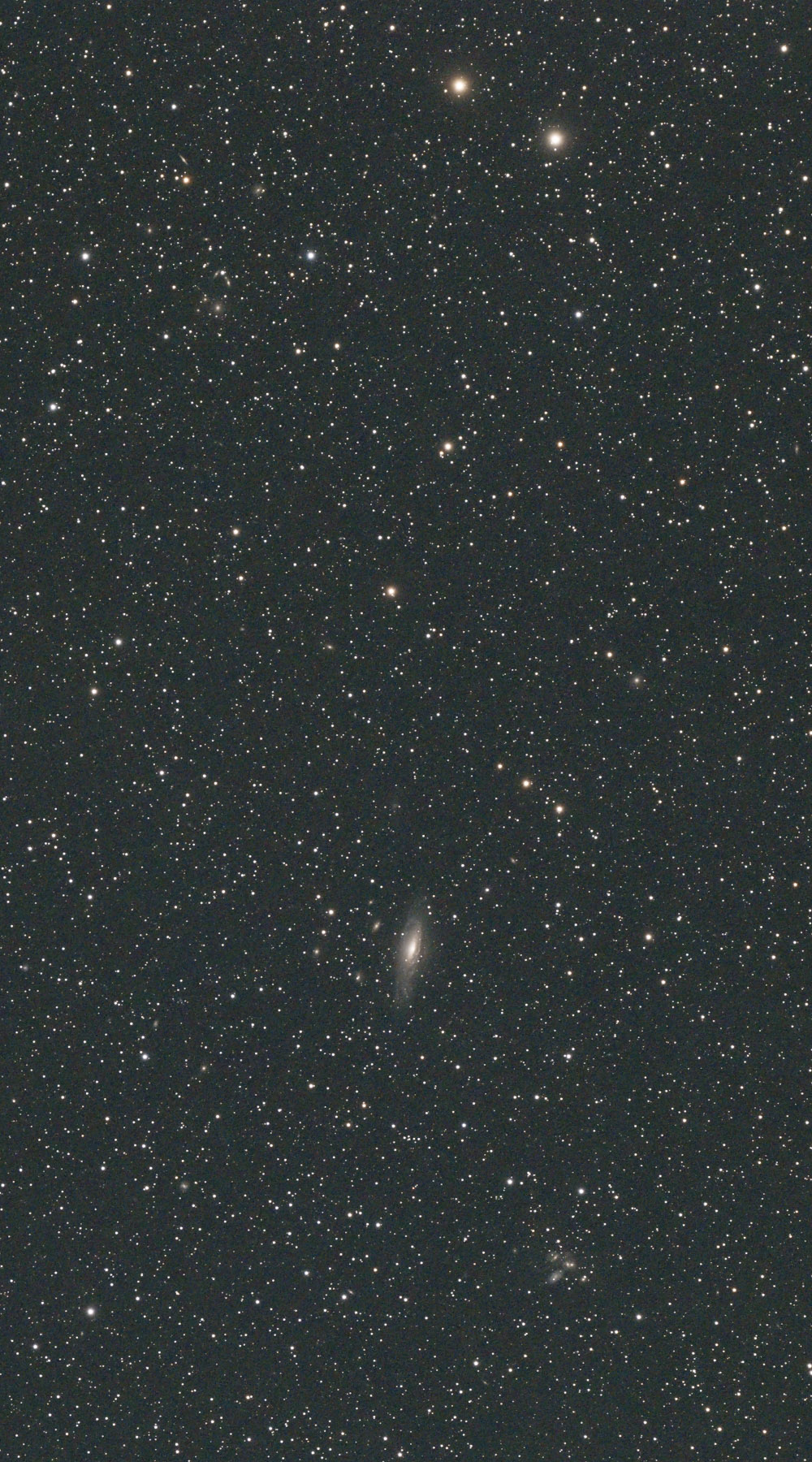
|
| |
The brightest galaxy is NGC 7331, and just to its left are the other members of the
Deer Lick Group. Toward the lower right is a conspicuous cluster, Stephan's Quintet.
But there are also many other galaxies in the picture, some of them barely known to science
(that is, when I check Simbad, I find that someone has noted the presence of a galaxy
but almost nothing is known about it). It is a sobering reminder that most of the universe
is not even discovered yet. And it is also striking how much I can photograph with a small
telescope, making images directly comparable to (though not identical to) the famous
Palomar Sky Survey.
Stack of 57 2-minute exposures with an AT65EDQ refractor (6.5 cm, f/6.5) and a Canon
60Da at ISO 640. This probably marks the end of a series of warm, clear nights;
as I write this the following evening, the clouds are rolling in.
Permanent link to this entry


|
2023
November
5
|
NGC 7380 (Wizard Nebula)
The first three nights of November were clear, mild, and very suitable for
astrophotography.
I set up my Losmandy GM811G mount in the driveway, put my AT65EDQ refractor on it
(6.5 cm aperture, f/6.5), and took and stacked multiple exposures with my Canon 60Da,
making guiding corrections with a tiny iOptron iGuider bolted to the side of the
mount saddle, and all controlled by N.I.N.A. and PHD2 software running on my
ThinkPad T490s — which I was able to access remotely from indoors to keep an
eye on things.
Here is NGC 7380, called, for some reason, the Wizard Nebula.
To the eye, this is just a cluster of stars, discovered as such by
Caroline Herschel in 1787, but the camera picks up red glowing hydrogen clouds.
This is one of the many nebulae along the Milky Way in the direction of Cepheus
that I was exploring with a wider-field instrument last month.
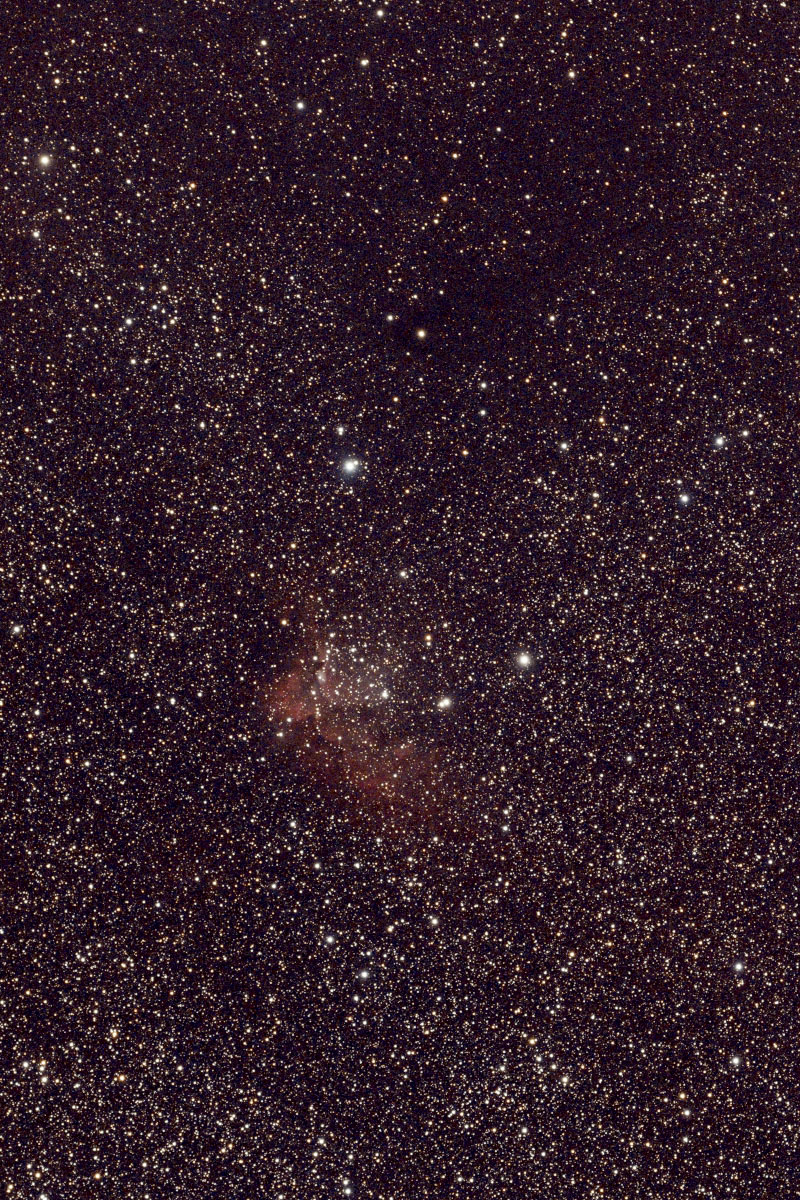
In the picture you can also see a dark nebula (dust cloud) at the upper right,
known as LDN 1200, and rich clouds of stars in the bottom half of the pictures.
Stack of just 24 2-minute exposures. I would have taken more, but I had only a short
time between the end of twilight and moonrise.
Permanent link to this entry
M33 without guiding
After the moon rose, I decided to test how well this mount would track the stars
without guiding corrections, so I turned off the autoguider and took aim at the
galaxy M33 in Triangulum, which I've photographed many times before.
I knew I wouldn't get top quality because of the moonlight; the question was
whether I would get adequate tracking.

I was pleasantly surprised. I took eight 2-minute exposures,
and all 8 were well tracked. This was a Losmandy GM811G with PEC turned off.
It tracked at least as smoothly as my AVX with PEC turned on.
I am thinking of upgrading the mount's firmware to Level 6, which has smoother
tracking (because the motor's position is checked 4 times as often) but, in its
present version, lacks PEC. Maybe I don't need PEC.
Here is the guiding graph (from PHD2 and PHD Log Viewer, RA only)
for the exposures without corrections:

Apart from the steady drift, the RA error is only about 2.5" RMS, or a bit less.
The steady drift is 20 arc-seconds in 12 minutes of time, or about 1 part in 500,
and (if I understand the software correctly)
is in a direction that would suggest the motor is running 0.2% slow (I think),
or there is quite a bit of flexure.
(Update:) Apart from the drift, the error is only 1.62" RMS!
Click here for how I calculated that in R,
and here for a reusable Quarto document into which
you can put your own data.
(Update:) That drift could be caused by a 10-arc-minute error in polar
axis altitude, but I don't think the alignment was that bad, unless something shifted
after alignment. Before I do anything else I am going to see if it reproducible.
It is not interfering with my astrophotography.
Permanent link to this entry
Sh 2-132 (Lion Nebula)
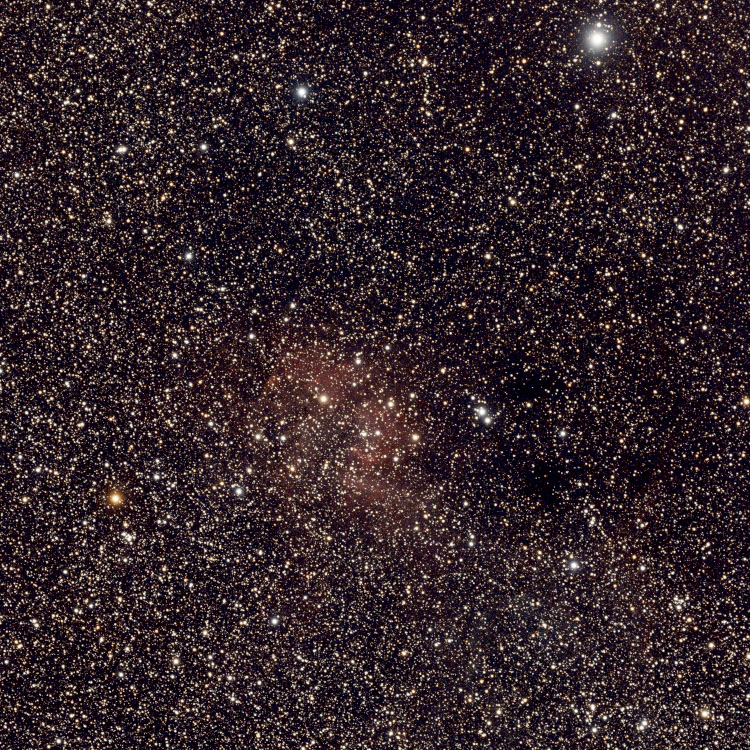
This one is called the Lion Nebula or Sharpless 2-132 (in the Sharpless catalog
of nebulae). This was taken the next night (Nov. 2) and the moon rose later,
so I let my automated camera take a total of 69 exposures, resulting in a
very-low-noise image.
Permanent link to this entry
NGC 7635 (Bubble Nebula) and M52

The object in the middle is called the Bubble Nebula because gas emissions
from a hot, active star have blown a bubble in the gas cloud, which was already there.
Here's the central part of the picture, cropped, at full resolution:

This is a stack of 84 exposures, which is probably excessive, but the camera and guider were
working well, so I let everything keep running for a long time.
Other objects in the bigger of the two pictures include
the star cluster M52 prominent at left, the nebula NGC 7538 at right,
and the small, bright nebula Sh 2-157 at the lower right, in a larger
reddish nebulous region.
Permanent link to this entry


|
| |

|
|
|
This is a private web page,
not hosted or sponsored by the University of Georgia.
Copyright 2023 Michael A. Covington.
Caching by search engines is permitted.
To go to the latest entry every day, bookmark
https://www.covingtoninnovations.com/michael/blog/Default.asp
and if you get the previous month, tell your browser to refresh.
Portrait at top of page by Sharon Covington.
This web site has never collected personal information
and is not affected by GDPR.
Google Ads may use cookies to manage the rotation of ads,
but those cookies are not made available to Covington Innovations.
No personal information is collected or stored by Covington Innovations, and never has been.
This web site is based and served entirely in the United States.
In compliance with U.S. FTC guidelines,
I am glad to point out that unless explicitly
indicated, I do not receive substantial payments, free merchandise, or other remuneration
for reviewing or mentioning products on this web site.
Any remuneration valued at more than about $10 will always be mentioned here,
and in any case my writing about products and dealers is always truthful.
Reviewed
products are usually things I purchased for my own use, or occasionally items
lent to me briefly by manufacturers and described as such.
I am no longer an Amazon Associate, and links to Amazon
no longer pay me a commission for purchases,
even if they still have my code in them.
|
|




















